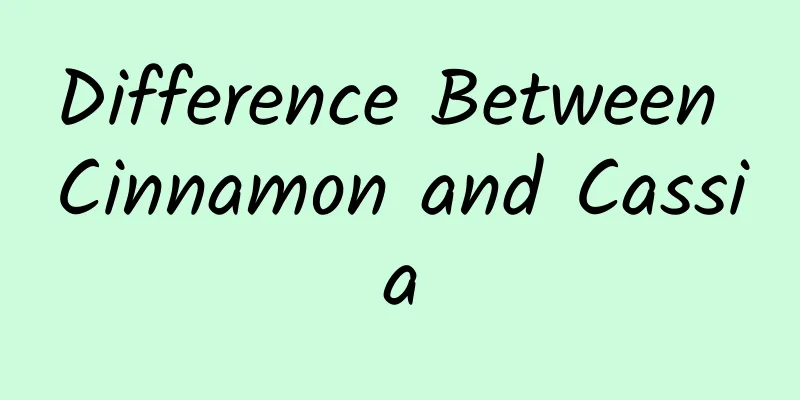Difference Between Cinnamon and Cassia

|
Cinnamon and cassia bark are very common in daily life. Because they have certain similarities, many people easily confuse the two. In fact, as long as you observe carefully, there are many differences between cinnamon and cassia bark in terms of plant origin, appearance, ingredients, functions and indications. Friends who are interested can learn the relevant knowledge in detail to better distinguish them. 1. Plant Source Both are plants of the Lauraceae family. Cinnamon is the dried bark of the cinnamon plant of the Lauraceae family. Cassia bark (Sri Lankan cinnamon) is the bark of Cinnamon bark, Cinnamon bark, Cinnamon bark, Cinnamon bark, etc. 2. Appearance Both are in the shape of a groove or a roll. Cinnamon: 0.2~0.8cm thick. The outer surface is gray-brown and slightly rough, with gray-white markings visible in some places; the inner surface is reddish-brown, slightly flat, with fine longitudinal lines, and oil marks can be seen when scratched. It is hard and brittle, easy to break, with an uneven cross section. The outer layer is brown and rough, the inner layer is reddish brown and oily, and there is a yellow-brown line between the two layers. The best ones are those with thin skin and thick flesh, purple-red cross-section, high oil content, strong aroma, sweet and slightly spicy taste, and no residue when chewed. Cinnamon: 0.1~0.2cm thick. The outer surface is black-brown to dark brown, with gray-white spots, cork or fish-scale peeling and turtle-like concave spots; the inner surface is reddish brown to black-brown, flat, with very fine longitudinal lines, and no oil marks when scratched. It is hard and brittle, easy to break, with a flat cross section, a gray outer layer, a reddish-brown inner layer, and yellow-brown rays between the two layers. The aroma is fresh and cool, similar to camphor, and the taste is slightly sweet and spicy. The ones with thin skin and strong aroma are better. 3. Ingredients Both contain volatile oils (the main component is cinnamaldehyde), cinnamon about 1~2%; cassia bark about 1%, and the latter also contains eugenol, etc. IV. Function and Indications Cinnamon: spicy, sweet, and very hot. It enters the kidney, spleen, heart and liver meridians. Replenish fire and assist yang, guide fire back to its source, dispel cold and relieve pain, activate blood circulation and dredge menstruation. It is used for impotence, cold uterus, cold pain in the waist and knees, asthma due to kidney deficiency, dizziness due to yang deficiency, red eyes and sore throat, cold pain in the heart and abdomen, vomiting and diarrhea due to deficiency and cold, cold hernia, amenorrhea, and dysmenorrhea. Those with yin deficiency and excess fire should not take it, and pregnant women should take it with caution. Cinnamon: spicy, warm. It enters the heart, liver, spleen and kidney meridians. Warms the spleen and stomach, dispels wind and cold, and unclogs blood vessels. It is used for cold abdomen and chest fullness, vomiting and choking, rheumatic arthralgia, falls and blood stasis, bloody diarrhea and intestinal wind. People with yin deficiency and fire should not take it. To sum up, cinnamon and cassia bark are similar in size but different in size, and can be distinguished by their thickness, color, surface and cross-sectional characteristics, and smell. Generally, cinnamon is mainly used as medicine (it has been included in all previous editions of the Pharmacopoeia except the 1953 edition); cassia bark is mainly used as a condiment in dishes (there is no special entry for cinnamon bark in the Compendium of Materia Medica, and it has not been included in all previous editions of the Pharmacopoeia). When using cinnamon, if the symptoms are as mentioned above and if it is indicated by the functions and indications of cinnamon, you can add cinnamon to dishes (but not as much as adding cinnamon bark to soups or dishes), but it is forbidden to use it in spring and summer. If you only want to use it as a condiment for dishes, it is better to choose cinnamon bark, which is generally sold in large Chinese medicine stores and Chinese medicine hospitals and is cheap. |
<<: How to deal with low self-esteem
Recommend
In 10 days, a "dart" 11 million kilometers away will hit an asteroid. Do you want to watch it?
On September 26, the DART spacecraft, nicknamed &...
ORC International: Survey shows social media has fully penetrated the tourism industry
Accor's second social media monitoring in Asi...
If you don’t understand, just ask, why are there silkworm pupae hanging on ginkgo trees?
Before reading the article, a reminder The pictur...
The most terrifying head-patting curse: If I touch your head, you will give me your child to eat.
👇This article contains pictures of ants and spide...
Effects and functions of Artemisia argyi root
With the development of society and the close int...
Effects and functions of honeysuckle and wolfberry
Honeysuckle tea and wolfberry are very common in ...
Characteristics of Plantain
What are the characteristics of plantain? Plantag...
The efficacy and function of bright leaf jasmine
Chinese medicinal materials are very effective in...
The efficacy and function of large flying grass
In fact, the occurrence of many human diseases is...
How to light? It's determined by your actions
Novel motion lighting control technology In today...
The efficacy and function of Liangshan Cordyceps
As people's research on traditional Chinese m...
The only blue-blooded creature on Earth! It once saved countless lives, but is now on the verge of extinction | World Horseshoe Crab Day
In 2019, the World Conservation Union classified ...
Effects and functions of mountain twist root
Not only does the mountain twist fruit have thera...
What is Motherwort
Motherwort is a medicinal herb we use to stop ble...
Is ibuprofen addictive? Are you taking ibuprofen correctly for menstrual cramps?
Author: Zhai Yan, Chief Physician, Department of ...









